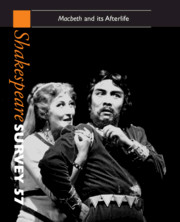Book contents
- Frontmatter
- Humane Statute and the Gentle Weal: Historical Reading and Historical Allegory
- Macbeth’s Knowledge
- ‘The Grace of Grace’ and Double-Talk in Macbeth
- Remind Me: How Many Children Had Lady Macbeth?
- Taking Macbeth out of Himself: Davenant, Garrick, Schiller and Verdi
- ‘Two truths are told’: Afterlives and Histories of Macbeths
- Doing All That Becomes a Man: The Reception and Afterlife of the Macbeth Actor, 1744–1889
- Macbeth and Kierkegaard
- Monsieur Macbeth: from Jarry to Ionesco
- The Politics of Sleepwalking: American Lady Macbeths
- Macbird! and Macbeth: Topicality and Imitation in Barbara Garson’s Satirical Pastiche
- Mick Jagger Macbeth
- ‘The Zulu Macbeth’: The Value of an ‘African Shakespeare’
- ‘A Drum, a Drum – Macbeth doth come’: When Birnam Wood moved to China
- The Banquet of Scotland (PA)
- Scoff power in Love’s Labour’s Lost and the Inns of Court: Language in Context
- Mercury, Boy Yet and the ‘Harsh’ Words of Love’s Labour’s Lost
- Shakespeare, Sir Thomas More and Asylum Seekers
- Hal as Self-Styled Redeemer: The Harrowing of Hell and Henry IV Part 1
- Mr Hamlet of Broadway
- Shakespeare Performances in England, 2003
- Professional Shakespeare Productions in the British Isles January–December 2002
- The Year's Contributions to Shakespearian Study 1 Critical Studies
- 2 Shakespeare in Performance
- 3 Editions and Textual Studies
- Books Received
- Index
‘A Drum, a Drum – Macbeth doth come’: When Birnam Wood moved to China
Published online by Cambridge University Press: 28 March 2007
- Frontmatter
- Humane Statute and the Gentle Weal: Historical Reading and Historical Allegory
- Macbeth’s Knowledge
- ‘The Grace of Grace’ and Double-Talk in Macbeth
- Remind Me: How Many Children Had Lady Macbeth?
- Taking Macbeth out of Himself: Davenant, Garrick, Schiller and Verdi
- ‘Two truths are told’: Afterlives and Histories of Macbeths
- Doing All That Becomes a Man: The Reception and Afterlife of the Macbeth Actor, 1744–1889
- Macbeth and Kierkegaard
- Monsieur Macbeth: from Jarry to Ionesco
- The Politics of Sleepwalking: American Lady Macbeths
- Macbird! and Macbeth: Topicality and Imitation in Barbara Garson’s Satirical Pastiche
- Mick Jagger Macbeth
- ‘The Zulu Macbeth’: The Value of an ‘African Shakespeare’
- ‘A Drum, a Drum – Macbeth doth come’: When Birnam Wood moved to China
- The Banquet of Scotland (PA)
- Scoff power in Love’s Labour’s Lost and the Inns of Court: Language in Context
- Mercury, Boy Yet and the ‘Harsh’ Words of Love’s Labour’s Lost
- Shakespeare, Sir Thomas More and Asylum Seekers
- Hal as Self-Styled Redeemer: The Harrowing of Hell and Henry IV Part 1
- Mr Hamlet of Broadway
- Shakespeare Performances in England, 2003
- Professional Shakespeare Productions in the British Isles January–December 2002
- The Year's Contributions to Shakespearian Study 1 Critical Studies
- 2 Shakespeare in Performance
- 3 Editions and Textual Studies
- Books Received
- Index
Summary
To the sound of strident percussion and martial music, an army emerged onto the stage in a swirl of colourful costumes and flags. The soldiers and generals with their elaborate acrobatic movements drew the audience’s attention to the entrance of Ma Pei, the Chinese Macbeth in the 1986 version. In Chinese productions of the play Macbeth’s entrance is always accompanied by the sound of percussion.
Few transformations of Shakespeare seem to Western eyes as extreme as the transfers into Chinese theatre. Strikingly, most Shakespeare performances in mainland China are of the comedies and romantic plays. Among the few Shakespeare tragedies ever staged, Macbeth has been by far the most performed. The predominant mode for staging Shakespeare is huaju, or spoken drama, a theatrical form devised at the beginning of the twentieth century on the basis of the Western dramatic tradition. However, among the nine mainland Macbeth productions, only three are spoken drama (including a radio play), while six are adaptations into different genres of the traditional Chinese music theatre.
The first spoken drama Macbeth, Huang Zuolin’s 1945 production entitled The Hero of the Turmoil, was an adaptation into an episode from Chinese history. By contrast, the 1980 Macbeth staged by a Moscow-trained director, Xu Xiaozhong, used Stanislavski’s Method and a straight translation of the play, together with costumes and make-up (including wigs, prosthetic noses, false eyelashes and blue colour on the eyelids) that were deliberately aimed at presenting an exotic medieval Scottish setting to the Chinese audience.
- Type
- Chapter
- Information
- Shakespeare SurveyAn Annual Survey of Shakespeare Studies and Production, pp. 169 - 185Publisher: Cambridge University PressPrint publication year: 2004
- 1
- Cited by



